Overhead Gantry Crane 5 -50 Ton for Heavy Concrete Penstock Pipes Lifting
Concrete Penstock Pipes: Overhead and Gantry Crane Solutions for Heavy Lifting
Concrete penstock pipes play a pivotal role in modern infrastructure, particularly in industries where the efficient transport of water, such as hydroelectric power generation, is essential. These robust structures, typically used for the conveyance of water under immense pressure, are essential components of hydroelectric power plants and irrigation systems. However, their construction and maintenance present significant challenges, primarily related to the weight and size of the concrete segments involved. To overcome these hurdles, innovative solutions are required. One such solution is the use of overhead and gantry cranes for heavy lifting operations.
Concrete penstock pipes are cylindrical conduits made from reinforced concrete, designed to withstand the high pressure generated by the flow of water. They are integral to the operation of hydroelectric power plants, where they carry water from the reservoir to the turbines, generating electricity in the process. These pipes are significant due to their role in providing clean and renewable energy, contributing to a sustainable future.
The construction and maintenance of concrete penstock pipes demand the handling of massive segments, each weighing several tons. These segments must be precisely positioned and connected to ensure the integrity and performance of the pipeline. Heavy lifting is crucial during installation, repairs, and maintenance, making it a critical aspect of penstock pipe projects. Without effective heavy lifting solutions, these operations would be cumbersome, time-consuming, and prone to safety hazards.
Overhead and gantry cranes are specialized machines designed to lift and transport heavy loads within various industrial settings. These cranes are engineered for stability, precision, and safety. In the context of concrete penstock pipes, overhead and gantry cranes offer an efficient and reliable solution to handle the substantial weight of concrete segments, easing the challenges associated with their construction and maintenance.
Concrete Penstock Pipes
Concrete penstock pipes, as mentioned earlier, are cylindrical conduits constructed from reinforced concrete. They are designed to transport water, typically under high pressure, from a source (such as a reservoir) to various destinations within hydroelectric power plants, irrigation systems, or other applications where water conveyance is critical. The concrete used in these pipes is specially formulated to withstand the immense pressure and potential exposure to harsh environmental conditions. The cylindrical shape of the pipes minimizes friction, allowing for efficient water flow.
Materials and Construction Methods
The construction of concrete penstock pipes involves meticulous planning and the use of high-quality materials. The primary components include:
- Concrete: High-strength, durable concrete is used to withstand the pressure and wear and tear associated with water flow. Reinforcement materials like steel bars or mesh are added to enhance the pipe's structural integrity.
- Formwork: To shape the pipes, formwork is employed. The formwork provides the necessary mold for casting the concrete segments in the desired cylindrical shape.
- Joints and Sealing: Proper joints and sealing materials are used to ensure a watertight connection between pipe segments. This is crucial to prevent leaks and maintain the efficiency of the pipeline.
- Transportation and Installation Equipment: Given the size and weight of concrete pipe segments, specialized equipment such as cranes and lifts are used for transportation and installation.
Typical Applications and Industries that Use Concrete Penstock Pipes
Concrete penstock pipes are widely employed in various industries and applications, including:
- Hydroelectric Power Generation: These pipes are an integral part of hydroelectric power plants, where they transport water from the reservoir to the turbines. This process generates electricity, making concrete penstock pipes essential for clean and renewable energy production.
- Irrigation Systems: Concrete penstock pipes are used in large-scale irrigation systems to efficiently distribute water to agricultural fields, helping to improve crop yields and support farming communities.
- Water Supply: Municipal water supply systems may also use concrete penstock pipes for the transportation of water from sources like reservoirs to treatment facilities or distribution networks.
- Mining Operations: In mining, these pipes are employed for various purposes, including tailings transport, dewatering, and slurry transport, where the durable concrete construction is advantageous.
Heavy Lifting Challenges
Discuss the Challenges and Requirements for Heavy Lifting in Penstock Pipe Projects
The handling of concrete penstock pipes is no small feat. These pipes can vary significantly in size and weight, with segments often exceeding several tons. The challenges associated with heavy lifting in penstock pipe projects include:
- Weight and Size: Concrete pipe segments are incredibly heavy and bulky, requiring specialized equipment capable of lifting and maneuvering them precisely.
- Positioning Precision: The segments must be accurately positioned to ensure proper alignment and sealing, which is vital for the integrity and efficiency of the pipeline.
- Safety Concerns: Heavy lifting operations present safety risks to both workers and the surrounding environment. Proper safety measures and equipment are necessary to mitigate these risks.
- Efficiency: Efficient handling and installation are critical to ensure that construction and maintenance timelines are met, minimizing downtime.
In the next section, we will explore the benefits of using overhead crane solutions for heavy lifting in penstock pipe projects, along with an introduction to different types of overhead and gantry cranes.
Overhead and Gantry Crane Solutions
Introduction to overhead and gantry cranes and Their Types
Overhead and gantry cranes, also known as bridge cranes, are essential tools in the world of heavy lifting. These cranes are designed to move heavy objects horizontally and vertically within industrial settings. They come in various types, each suited to specific applications. The common types of overhead and gantry cranes include:
- Single Girder Overhead Crane: This type features a single girder or beam for supporting the hoist and trolley. It's ideal for light to moderate lifting applications.
- Double Girder Overhead Crane: These cranes have two girders for added stability and capacity, making them suitable for heavier lifting tasks.
- Gantry Crane: Gantry cranes are versatile and can be used both indoors and outdoors. They have legs or supporting structures on wheels, allowing for mobility.
- Jib Crane: Jib cranes have a horizontal jib or boom that can rotate, providing a high degree of precision and flexibility for lifting tasks.
The design and tonnages of overhead and gantry cranes used for concrete penstock pipes manufacturing and handling can vary depending on the specific requirements of the project and the size and weight of the concrete penstock pipes. However, here are some typical design features and tonnages for overhead and gantry cranes used in this context: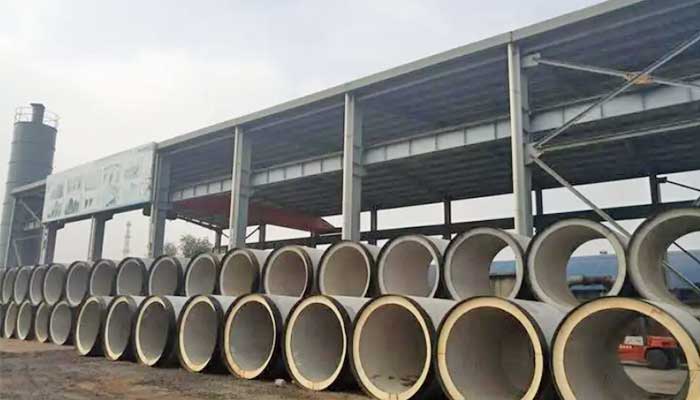
Features:
- Single girder configuration with one bridge beam.
- Suitable for lighter and less frequent lifting tasks.
- Economical choice for smaller projects and workshops.
Benefits:
- Cost-effective solution for less demanding applications.
- Easy to install and maintain.
- Suitable for confined spaces.
Functions:
- Lifting and transporting concrete penstock pipes.
- Precise positioning with adequate control systems.
- Suitable for tasks where a lower headroom is required.
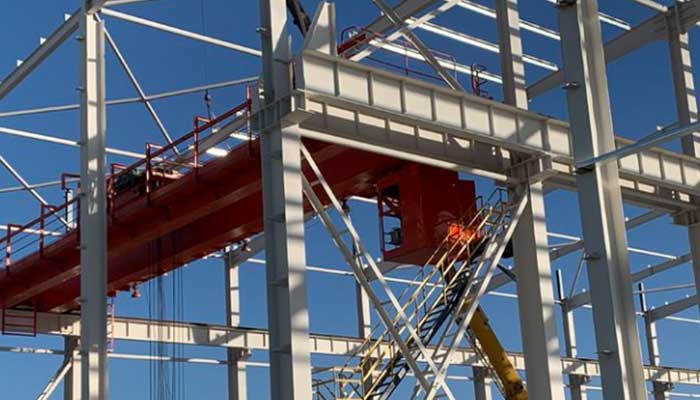
Features:
- Two bridge beams for increased stability and load-bearing capacity.
- Ideal for heavy-duty and frequent lifting tasks.
- Can handle larger and heavier concrete penstock pipes.
Benefits:
- High lifting capacity and stability.
- Suitable for demanding and continuous operations.
- Excellent for handling larger and heavier pipes.
Functions:
- Lifting, transporting, and positioning concrete penstock pipes.
- Ensuring safe and precise handling, even with heavy loads.
Rail Mounted gantry cranes and rubber-tired gantry cranes (RTGs) are also used in various industries for material handling, including the handling of concrete penstock pipes. Here's an overview of these crane types and their applications in concrete penstock pipe handling: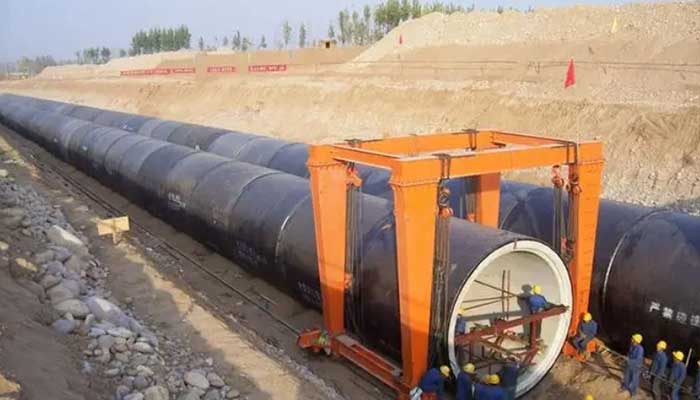
Rail Mounted Gantry Crane:
Features:
- Rail Mounted gantry cranes are typically fixed structures with a single or double girder design.
- They are mounted on rails on one side of the work area, allowing the crane to move along the rails.
- The design of Rail Mounted gantry cranes ensures lateral movement, while the vertical movement is achieved through lifting mechanisms.
Benefits:
- These cranes are ideal for applications where lateral movement is required, such as moving materials within a specific area.
- They are suitable for tasks where loads need to be transported along a linear path.
Functions:
- Rail Mounted gantry cranes can be used for the lateral transport of concrete penstock pipes within a manufacturing facility or construction site.
- They are effective for linear loading and unloading tasks.
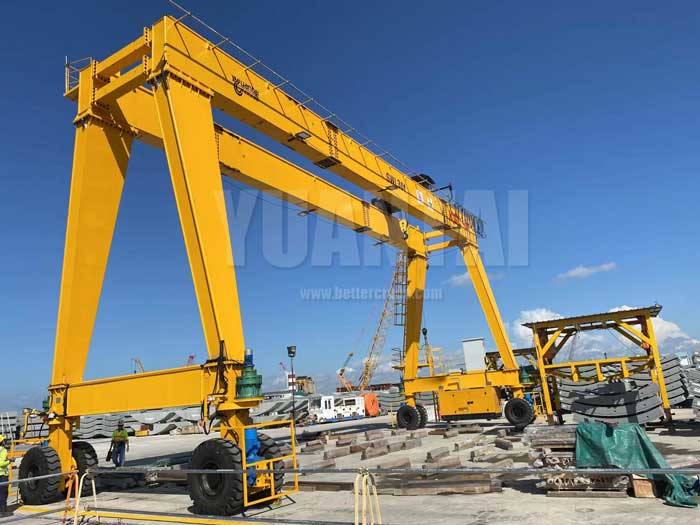
Rubber-Tired Gantry Crane (RTG):
Features:
- RTGs are mobile gantry cranes that are mounted on rubber tires instead of rails.
- They are self-propelled and can move freely within a designated area, making them highly versatile.
- RTGs are typically used in outdoor environments and container handling at ports, but they can also be adapted for various industrial applications.
Benefits:
- RTGs offer excellent mobility, making them suitable for outdoor concrete penstock pipe handling at construction sites, storage yards, and manufacturing facilities.
- They can be easily relocated to different job sites.
Functions:
- RTGs are employed for the lifting, transport, and positioning of concrete penstock pipes within large outdoor areas.
- They are effective for handling pipes of various sizes and weights.
In the context of concrete penstock pipe handling, the choice between a Rail Mounted gantry crane and an RTG depends on the specific requirements of the project:
Rail Mounted Gantry Crane: Suitable for tasks that involve linear movement and precise positioning of concrete penstock pipes within a fixed workspace. They are commonly used in manufacturing facilities and construction sites where lateral movement is required.
Rubber-Tired Gantry Crane (RTG): Ideal for outdoor applications where mobility is essential, such as in storage yards and large construction sites. RTGs are highly flexible and can be adapted for various pipe handling tasks in different locations.
Both crane types have their advantages, and the selection depends on factors like the work environment, the size and weight of the concrete penstock pipes, and the need for mobility. Consulting with a crane expert can help determine the most suitable solution for your specific project.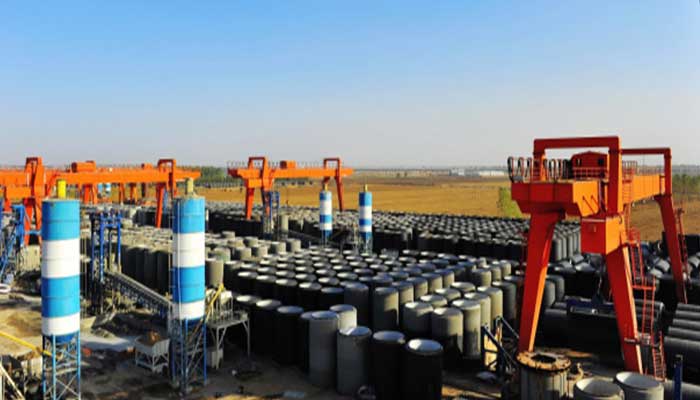
Double girder gantry crane for concrete penstock pipe handling
Design Features:
- Double Girder Cranes: Double girder overhead and gantry cranes are commonly used for heavy-duty applications, including handling concrete penstock pipes. They provide increased stability and load-bearing capacity.
- Customized Lifting Attachments: Cranes may be equipped with specialized lifting attachments, such as custom hooks or spreader beams, designed to securely hold and transport concrete penstock pipes.
- High Lifting Heights: To accommodate the height of penstock pipes, overhead and gantry cranes used in this context often have a high lifting capacity to reach and maneuver the pipes effectively.
- Precise Positioning Controls: Given the precision required for concrete penstock pipes, these cranes typically have precise positioning controls to ensure accurate placement and installation.
Tonnages and Capacities:
- Capacity: The capacity of overhead and gantry cranes for concrete penstock pipes can range from 5 tons to over 50 tons or more, depending on the size and weight of the pipes.
- Span: The span of the crane, which is the distance between the runways, can vary based on the specific project requirements and the layout of the manufacturing and handling area.
- Lifting Height: The lifting height of the crane should be sufficient to accommodate the height of the concrete penstock pipes, which can be quite tall.
- Hoist Speed: The hoist speed should be adjustable to ensure precise and controlled movement of the pipes.
- Load Control and Monitoring: overhead and gantry cranes may be equipped with load control and monitoring systems to prevent overloads and ensure safe handling.
It's essential to consult with a crane manufacturer or supplier who can assess the specific requirements of the concrete penstock pipe project and provide a crane solution that meets those requirements. The design and tonnage of the overhead crane should be tailored to the unique characteristics of the project to ensure safe and efficient handling of the concrete penstock pipes.
Features and Advantages of Using Overhead and Gantry Cranes for Heavy Lifting in Penstock Pipe Projects
overhead and gantry cranes offer a range of features and advantages that make them highly suitable for handling the heavy lifting requirements of concrete penstock pipe projects:
- High Load Capacity: overhead and gantry cranes are designed to handle heavy loads, making them suitable for lifting and positioning massive concrete pipe segments.
- Precision and Control: They provide precise control over the movement of the load, allowing for accurate positioning and alignment during installation.
- Efficiency: overhead and gantry cranes can move loads quickly, enhancing the efficiency of construction and maintenance operations.
- Safety: Safety is paramount, and overhead and gantry cranes are equipped with safety features such as overload protection and emergency stop mechanisms to ensure a secure work environment.
- Adaptability: overhead and gantry cranes can be customized to suit the specific needs of the project, including the design and configuration of lifting attachments.
Benefits of Using overhead and gantry cranes
Efficiency and Time-saving Advantages
Efficiency is a crucial factor in any construction or maintenance project, and overhead and gantry cranes offer significant advantages in this regard. The use of overhead and gantry cranes streamlines heavy lifting operations, reducing the time required for installation, repairs, and maintenance of concrete penstock pipes. Here are some key efficiency and time-saving benefits:
- Quick Installation: overhead and gantry cranes allow for the precise positioning of concrete pipe segments, minimizing the time required for assembly and alignment.
- Reduced Downtime: The efficiency of overhead and gantry cranes ensures that downtime is minimized, helping projects stay on schedule and avoiding costly delays.
- Faster Repairs: In the event of damage or maintenance requirements, overhead and gantry cranes can swiftly remove and replace concrete segments, reducing downtime and ensuring minimal disruption.
Improved Safety and Reduced Risks
Safety is paramount in heavy lifting operations, and overhead and gantry cranes are designed with numerous safety features to minimize risks. The advantages in terms of safety are significant and include:
- Operator Safety: overhead and gantry cranes are equipped with safety features like load limiters and emergency stop buttons, protecting both the operator and the surrounding environment.
- Accurate Positioning: The precision and control provided by overhead and gantry cranes reduce the risk of accidents, ensuring that concrete pipe segments are accurately placed and aligned.
- Reduced Manual Handling: overhead and gantry cranes eliminate the need for manual lifting, reducing the risk of injuries and strains for workers.
Cost-effectiveness and Long-term Benefits
While the initial investment in overhead and gantry cranes may be significant, their long-term benefits and cost-effectiveness make them a wise choice for handling concrete penstock pipes. The cost advantages include:
- Minimized Repairs and Replacements: Efficient handling and reduced wear and tear on pipe segments lead to fewer repairs and replacements, saving on maintenance costs.
- Reduced Downtime: Less downtime translates to increased productivity and revenue, offsetting the initial investment in overhead and gantry cranes.
- Enhanced Longevity: overhead and gantry cranes extend the lifespan of concrete penstock pipes by ensuring proper handling and reducing the risk of damage.
Considerations for Selecting overhead and gantry cranes
Factors to Consider When Choosing the Right Overhead Crane for Specific Penstock Pipe Projects
Selecting the appropriate overhead crane for penstock pipe projects involves considering several critical factors, including:
- Load Capacity: Determine the maximum weight of the concrete pipe segments and choose a crane with the required load capacity.
- Span and Coverage: Evaluate the area that needs to be covered by the crane and select a crane with an appropriate span and coverage.
- Environmental Conditions: Consider the environment in which the crane will operate, including factors like temperature, humidity, and exposure to the elements.
- Space Constraints: Assess the available space for crane installation and operation to ensure it fits within the project site.
Customization Options and Flexibility
overhead and gantry cranes can often be customized to meet the specific needs of penstock pipe projects. Customization options include:
- Lifting Attachments: Choose the right lifting attachments, such as hooks, grabs, or magnets, based on the nature of the concrete pipe segments.
- Control Systems: Select control systems that match the level of precision and automation required for the project.
- Safety Features: Customize safety features to align with project-specific safety regulations and requirements.
Maintenance and Operational Requirements
Consider the maintenance and operational requirements when selecting an overhead crane, including:
- Maintenance Schedule: Establish a maintenance schedule to ensure the crane operates smoothly and safely.
- Operator Training: Ensure that crane operators receive proper training and certification to operate the equipment safely and effectively.
- Spare Parts Availability: Check the availability of spare parts to minimize downtime in case of repairs.
Safety Measures
Overview of Safety Measures and Regulations in Heavy Lifting with overhead and gantry cranes
Safety is a top priority when using overhead and gantry cranes for heavy lifting in penstock pipe projects. It is essential to adhere to safety measures and regulations, which may include:
- Load Limiters: Use load limiters to prevent the crane from lifting loads beyond its capacity, reducing the risk of accidents.
- Safety Inspections: Conduct regular safety inspections to ensure the crane is in good working condition.
- Regulatory Compliance: Comply with local and national safety regulations governing the use of overhead and gantry cranes.
Training and Certification Requirements for Crane Operators
Crane operators must undergo proper training and certification to operate overhead and gantry cranes safely. Training should cover:
- Equipment Operation: Operators should be well-versed in operating the crane, including load handling and movement.
- Safety Protocols: Training should include safety protocols to prevent accidents and respond to emergencies.
Risk Mitigation Strategies
Implement risk mitigation strategies to ensure the safety of all workers and the environment:
- Emergency Response Plans: Develop and communicate emergency response plans to handle potential accidents effectively.
- Proper Communication: Establish clear lines of communication between operators and ground personnel during lifting operations.
- Safety Culture: Promote a safety culture among all workers involved in the project, emphasizing the importance of adhering to safety protocols.
Conclusion
Recap the Importance of Overhead Crane Solutions in Handling Concrete Penstock Pipes
In conclusion, the use of overhead crane solutions in handling concrete penstock pipes is of utmost importance. These cranes provide a range of benefits, from efficiency and safety to long-term cost-effectiveness. They play a crucial role in ensuring that penstock pipe projects are executed with precision and effectiveness.
Emphasize the Benefits, Safety Measures, and Considerations for Successful Heavy Lifting Projects
The benefits of using overhead and gantry cranes for heavy lifting in penstock pipe projects are evident in their ability to enhance efficiency, improve safety, and deliver long-term cost savings. Safety measures and considerations are vital components of a successful heavy lifting operation, ensuring that projects are completed without incidents or delays.
Concluding Remarks on the Future of Heavy Lifting in the Construction and Maintenance of Concrete Penstock Pipes
As technology and safety standards continue to advance, the future of heavy lifting in the construction and maintenance of concrete penstock pipes appears promising. overhead and gantry cranes, with their efficiency, safety features, and adaptability, are set to play a central role in ensuring the reliability and sustainability of these critical infrastructure components. Their use is a testament to human innovation in harnessing the power of water to generate clean energy and support various industries.




